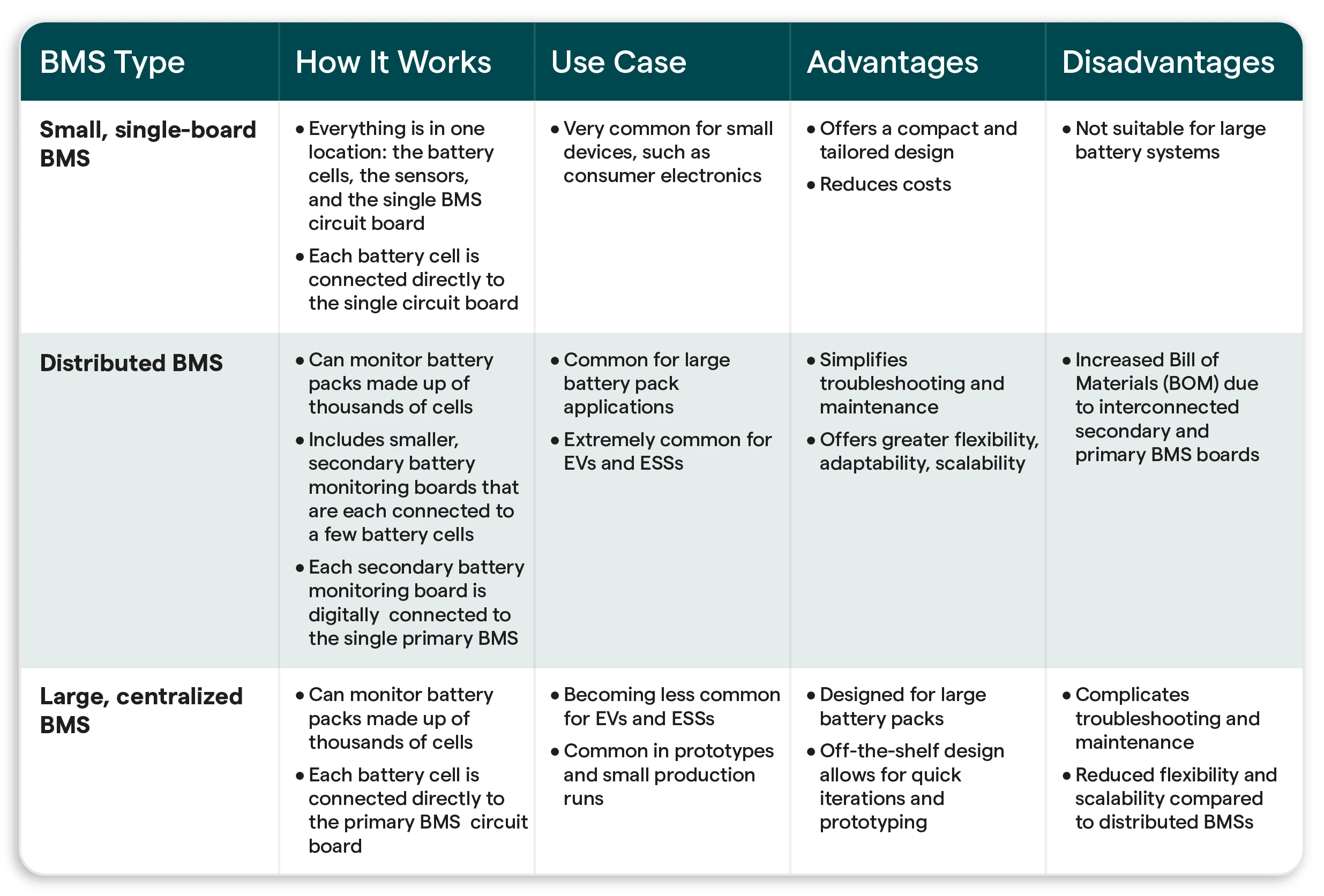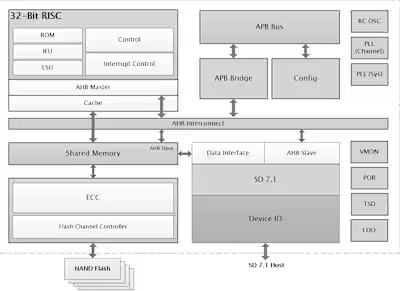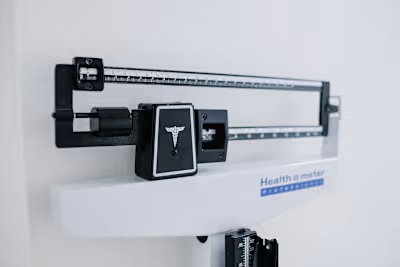What is a battery management system (BMS)?
Mastering Battery Management Systems (BMS): A Comprehensive Guide to Common BMSs (And How to Make Them Better)
A battery management system (BMS) is vital for the safe operation of any device that uses lithium-ion batteries. There are several different types of battery management systems, but all are responsible for protecting the battery pack and monitoring its performance at the hardware level. Unfortunately, the off-the-shelf software onboard commonly used BMSs are struggling to meet the needs of modern battery applications. That's why Zitara makes high-performance predictive algorithms to take battery management systems to the next level and empower teams to not only monitor their entire battery fleet in the real world today but also make predictions about future performance.
A battery management system (BMS
) is an electronic system that monitors all aspects of a battery pack. In many ways, a BMS can be thought of as the brains of the battery, as it houses all of the electronics and computation power in a battery pack.
More specifically, a BMS is often made up of several components, including but not limited to:
Analog Front-end: typically read from sensors in the pack such as temperature, voltage, and current sensors
Power electronics, e.g., switches and power supplies
Microcontroller(s) or microprocessor(s) for running software controls
External communication interfaces
And more
Lithium-ion batteries are a standard choice for battery packs in modern applications, such as electric vehicles (EVs), Energy Storage Systems (ESSs), eMobility, and many other devices, because they offer high energy density and strong performance. However, they can also result in damaging and downright dangerous consequences if not operated correctly.
For this reason, you’ll find a BMS in every responsible device that contains lithium-ion batteries - these hardware capabilities are the minimum requirements for basic functionality.
However, BMSs only come with guarantees on direct hardware measurement performance. For instance, they guarantee the accuracy of cell voltage or current monitoring, and can guarantee a shutdown if these directly observed signals move out of preset safe operating boundaries.
Off-the-shelf software onboard BMSs is a different story. BMSs often also offer software features to estimate battery State of Charge
(SoC), and sometimes also State of Health (SoH). These software algorithms are not typically tuned or guaranteed for performance on customer systems, and do not detect safety anomalies proactively - they may be inaccurate on day one, and typically degrade rapidly in accuracy as a battery ages.
Three types of battery management systems
It’s important to note that not all BMSs are built in the same architecture. There are, in fact, several different kinds of BMSs, each with different setups and features.
In total, there are three common types of BMS architectures:
Small, single-board BMS
Distributed BMS
Large, centralized BMS

A BMS is vital for ensuring a battery pack’s safe operation, health, longevity, and overall performance.
Typically, a BMS has a few primary roles:
Protect people and the battery pack
Optimize the performance of the battery pack
Monitor and report on the battery pack’s status
Modern BMSs are also often capable of another role: using advanced battery model
ing algorithms to compute and make predictions about the battery’s performance, now and into the future.
Let’s explore how a BMS carries out each of these roles.
1. How does a BMS protect people and the battery pack?
A BMS’s first and most important job is to protect people and the battery pack. Since lithium-ion batteries can create a safety hazard if subjected to abusive conditions, one of the ways a BMS protects both people and the battery itself is by ensuring the battery pack stays within its safe operating area
(SOA), thereby reducing the likelihood of a dangerous event.
First, what is SOA? The SOA is defined by the battery cell
manufacturer. It is the limits within which the battery pack must always remain in order to guarantee safe operation.
The SOA of a battery cell typically consists of at least 3 dimensions: temperature, voltage, and current.
Temperature
The temperature SOA defines the range between two temperatures that the battery cells must operate within. If any battery cell reaches a temperature outside of this range, the BMS should take corrective action to prevent damage and/or safety hazards before they arise.
For example, suppose the battery pack charges very quickly, causing the cells to heat up and exceed the maximum temperature set by the SOA. When it does, the BMS should turn off the battery pack to stop it from further charging and getting even hotter. Once the battery cells cool down and return to a temperature within the SOA, the BMS should allow charging to resume. In systems with active cooling, the BMS may also request cooling as the battery heats up in an attempt to keep the battery within its temperature SOA.

Example Temperature SOA for a Lithium Ion Battery
Voltage
The voltage SOA defines the range between two voltages that the battery cells must operate within. Just as it measures the temperature, the BMS regularly measures the voltage of the battery pack’s cells. If the cells are charged or discharged beyond the voltage SOA, the BMS should turn off the battery pack.

Example Voltage SOA for a Lithium Ion Battery
Current
The current SOA defines the range of positive and negative currents between which the battery pack must operate. If the battery pack is charged or discharged at a rate outside of the current SOA, the BMS should, once again, turn off the battery pack to prevent safety hazards.
Example Current SOA for a Lithium Ion Battery
Multidimensional SOA
Note that these three SOA dimensions can also be interdependent, as shown in the below example where the safe charge current of the cell (shown as negative current) is reduced at low temperatures while the safe discharge current of the cell (shown as positive current) remains constant across the range of the cell’s operating temperature.
The bottom line
To recap, the primary job of a BMS is to protect people and the battery. One way it does this is by disabling the battery pack whenever it falls below or exceeds any dimension of the battery’s SOA.
2. How does a BMS optimize the performance of the battery pack?
In normal operation, the cells of a battery pack may begin to drift out of balance relative to one another, leaving some with a little more charge and some with a little less. Importantly, a BMS has the necessary hardware to perform cell balancing, which is the process of bringing battery cells back to equal states of charge (SoC).
Unfortunately, the software algorithms required to perform cell balancing are tricky to get right. That’s why we’ve written an entire blog post to show how model-based algorithms can significantly improve cell balancing on BMS hardware.
Another job of a BMS is to monitor and report on the battery pack’s status.
As stated, a BMS regularly monitors the battery pack’s temperature, voltage, and current. It does so by reading values from its sensors. A BMS may then report those values to systems connected to the battery pack, e.g., vehicle powertrains, Energy Management Systems (EMSs), or any relevant users.
In some devices, receiving communication from the BMS isn’t necessary. But even when it’s not required, increased BMS communication can often benefit both devices and users by providing information for more accurate and optimized battery use. For example, a BMS can communicate:
Status of a USB power bank via LEDs
Range remaining on an EV via the dashboard and mobile devices
Peak shaving statistics to a grid operator
Finally, an essential job of a modern BMS is to compute and predict the behavior and health of the battery pack. This is made possible via advanced BMS software tools, such as Zitara Live.
Remember that a BMS is always monitoring and reporting data on the battery’s performance, i.e., its temperature, voltage, and current. Accordingly, BMS software tools can use this data to inform model-based algorithms that make predictions about the battery pack and its future performance.
For example, with Zitara Live’s advanced model-based algorithms, a BMS can measure and predict the State of Health (SoH) and the State of Charge (SoC) of a battery pack’s cells and then determine how this impacts both the present and future performance of the battery. With these algorithms, the energy and power available at any given moment is no longer a mystery.
Moreover, with this information, it is possible to make accurate predictions, such as:
How much range an EV has left
How much power can be safely discharged from a battery over the next ten seconds
How long it will take for a battery to reach a given SoC
How much energy an Energy Storage System (ESS) can deliver to the grid
How to optimize future charging profiles for battery health
And so much more
These BMS software tools are essential for anyone designing or operating batteries in real-world applications, as they unlock the ability to use SoC, SoH, and LookAhead
estimations for critical decision-making.
Zitara takes BMSs to the next level with high-performance predictive algorithms
No matter the type of battery management system you employ, your BMS plays an important role in battery applications by providing complete oversight of the battery pack and its connected systems. This information is crucial to ensure not only optimal performance but also the safety of both the battery pack and its connected systems.
Unfortunately, the most commonly used tools on the market are struggling to meet the needs of modern battery applications. Moreover, most BMS chips and analytics providers are unable to deliver reliable metrics for battery degradation nor useful estimates of battery performance.
The main problem for experienced battery teams is the lack of predictability and certainty. When your product is out in the field, fleet-wide battery performance can vary greatly. This means that there is no certain way to know the status of your batteries’ capabilities—nor how their capabilities change over time.
That is where Zitara’s model-based algorithms are stepping in to help.
Zitara Live is cloud-ready embedded battery management software that works with your existing and future BMSs on any battery chemistry
. Even better, Zitara Live is completely customized to your batteries, offering key insights into not just battery cells but the nuances of your pack design.
Built on cutting-edge model-based algorithms, Zitra Live enables you to monitor your batteries in the real world—both today and years into the future. It delivers customized and validated SoC, SoH, and safety outputs, as well as unmatched insights so you can safely and reliably operate your system for years to come.
Here’s how it works:
With accurate and validated model-based algorithms, Zitara Live continuously monitors every cell in your pack and every pack in your fleet, giving you a bird’s-eye view of all your assets—both on Day 1 and as they change over time. Notably, this keen level of insight enables Zitara Live to identify anomalies before they become problems—and then take action to set things right. For example, the software can dynamically tighten operating parameters and shutdown thresholds to prevent operational failure, safety risks, and unnecessary downtime.
Plus, Zitara Live is paired with the certifications and performance guarantees necessary to manage power for critical systems across diverse industries, such as mobility, storage, and aerospace.
But what really sets Zitara Live apart from the rest is its predictive capabilities.
Using precise, onboard, model-based algorithms, the software can predict your battery’s energy, power, degradation, and more, well into the future.
Some teams have been turning to custom algorithms developed by in-house battery teams for their particular battery packs. Others have been relying on BMS suppliers for algorithm support. But most BMSs fail to anticipate future battery performance and are unable to proactively monitor safety beyond simple static limits.
Worse yet, the SoC and SoH algorithms on the market today can only give you approximate information, at best. But when batteries are some of the most expensive and unpredictable parts in your operation, do you really want approximate? Approximate battery information only means one thing: uncertainty now and in the future. With your batteries and business on the line, approximations don’t cut it.
That’s why Zitara Live integrates with onboard controls and cloud operations and management software to give you a top-down, accurate view of what your assets look like and what their capabilities are—both today and tomorrow.
Ready to integrate your BMS with Zitara?
Zitara Live is cloud-ready embedded battery management software that’s completely customized for your needs—not just the lowest common denominator.
You can deploy it on your existing hardware to amplify your team’s capabilities and empower them to make the best engineering and design choices for your fleet, now and into the future.
Discover how to elevate your BMS with Zitara’s cutting-edge algorithms by getting in touch with our team.
You can also learn more about Zitara Live and how it helps you keep track of all your deployed batteries.
Do I need a BMS?
Even though lithium-ion batteries don’t technically need a BMS in order to function, you should not operate a lithium-ion battery pack without one. A BMS is crucial for monitoring a battery pack’s safe operating area (SOA), state of charge (SoC), state of health (SoH), and other important factors that contribute to the efficacy, longevity, and safety of your battery pack.
What is the biggest challenge in battery management systems?
The biggest challenge in battery management systems is lack of battery observability
. Today, the state of charge (SoC) and state of health (SoC) algorithms in most BMS hardware are only approximate at best. This is simply not sufficient for modern battery use cases. Particularly when batteries are some of the most expensive parts in your operation, having accurate, validated data is paramount.
The future of battery management systems is about leveraging new tools with the capabilities to monitor entire battery fleets in real-world applications. Specifically, cutting-edge model-based algorithms will play a role in providing accurate insights into batteries’ performance today with predictions for their capabilities tomorrow, and beyond.
One of the most important new trends in battery management systems is figuring out how to reduce battery degradation and predict battery performance. To do so, teams need cloud-ready embedded battery management software that integrates with their existing hardware to give them a birds’-eye view of their assets and their predicted future degradation. Only with this information can teams fully monitor their fleets and understand their batteries now and into the future.
Keep updated on Zitara insights, news, and events.
Like this project
Posted Jan 11, 2024
Ghostwrote an SEO-optimized technical blog post on battery management for software-solutions provider, Zitara.





